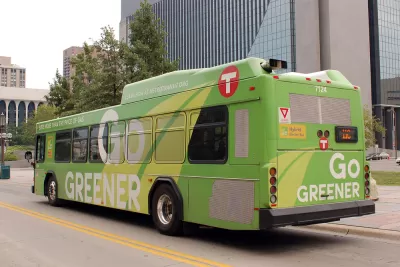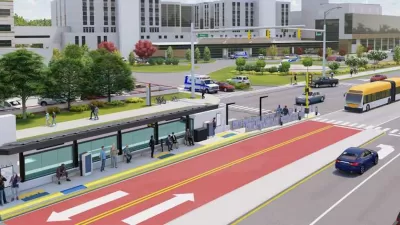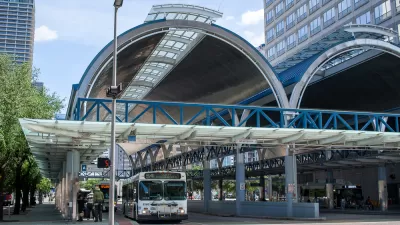The city wants to become North America’s ‘bus rapid transit capital.’

With the opening of its fifth bus rapid transit (BRT) line, Minneapolis is on its way to achieving its goal of becoming “the bus rapid transit capital of North America,” reports Jared Brey in Governing. “In all, the project includes 61 new bus shelters, 78 crosswalk restripings, 24 traffic signal upgrades and 246 electric heaters, which can be turned on by passengers at the press of a button.”
Unlike regular bus service, Metro’s BRT lines only stop at dedicated bus platforms every quarter- to half-mile. Riders pay their fares, before boarding, at well-lit stations with electric heaters and digital signs showing schedules and real-time arrival information. The buses are scheduled to come every 10-15 minutes.
Faster and more reliable than regular buses and cheaper to build than rail, bus rapid transit has seen ridership recover faster than other modes in Minneapolis after losing riders to the pandemic. According to Katie Roth, the director of arterial bus rapid transit at Metro Transit, introducing BRT boosted ridership on the system overall: “other bus lines in the Metro system saw 30 percent increases in ridership when they were switched to BRT, Roth says.”
Metro Transit has six more BRT lines in the works.
FULL STORY: Minneapolis Wants to Be the ‘Bus Rapid Transit Capital of North America’

Alabama: Trump Terminates Settlements for Black Communities Harmed By Raw Sewage
Trump deemed the landmark civil rights agreement “illegal DEI and environmental justice policy.”

Planetizen Federal Action Tracker
A weekly monitor of how Trump’s orders and actions are impacting planners and planning in America.

The 120 Year Old Tiny Home Villages That Sheltered San Francisco’s Earthquake Refugees
More than a century ago, San Francisco mobilized to house thousands of residents displaced by the 1906 earthquake. Could their strategy offer a model for the present?

In Both Crashes and Crime, Public Transportation is Far Safer than Driving
Contrary to popular assumptions, public transportation has far lower crash and crime rates than automobile travel. For safer communities, improve and encourage transit travel.

Report: Zoning Reforms Should Complement Nashville’s Ambitious Transit Plan
Without reform, restrictive zoning codes will limit the impact of the city’s planned transit expansion and could exclude some of the residents who depend on transit the most.

Judge Orders Release of Frozen IRA, IIJA Funding
The decision is a victory for environmental groups who charged that freezing funds for critical infrastructure and disaster response programs caused “real and irreparable harm” to communities.
Urban Design for Planners 1: Software Tools
This six-course series explores essential urban design concepts using open source software and equips planners with the tools they need to participate fully in the urban design process.
Planning for Universal Design
Learn the tools for implementing Universal Design in planning regulations.
Clanton & Associates, Inc.
Jessamine County Fiscal Court
Institute for Housing and Urban Development Studies (IHS)
City of Grandview
Harvard GSD Executive Education
Toledo-Lucas County Plan Commissions
Salt Lake City
NYU Wagner Graduate School of Public Service





























